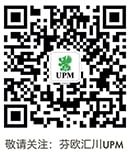(UPM Helsinki, 5 May, 2010) - UPM's paper selection tool 'UPM Paper Sommelier' has been awarded an innovation prize at Golden Cylinder Awards 2010 of GAA, Gravure Association of America, on 29 April, 2010 in the category for "Technical Innovations, inks and substrates".
The UPM Paper Sommelier is a tool that makes paper selection a simple process. Instead of paper profile data, UPM Paper Sommelier uses words and feelings to describe an ideal paper. Like a good sommelier in a restaurant helps to choose the perfect wine to match the order for food, UPM Paper Sommelier recommends a suitable paper for the purpose.
There are different attributes in UPM Paper Sommelier to describe the sensory experience of a printed product. These are colour experience, sharpness and feel, body and posture, print gloss and print through.
"The customer is able to choose one alternative from each of these categories and UPM Paper Sommelier provides the three best matching choices from UPM's product palette", explains Janne Varvemaa, developer of the original UPM Paper Sommelier concept and Portfolio Manager from UPM Research Center.
"We have recently released the UPM Paper Sommelier on our website for Russia. We are constantly developing this tool to make paper selection easier for our customers", says Elina Keskinen, Marketing Manager, Paper Business Group. The English version of UPM Paper Sommelier is in use in selected countries by UPM Technical Sales.
Golden Cylinder Awards Competition 2010 judging took place in February and the winners were announced during GAA 2010 Leadership Summit held 27-29th of April in Parsippany, New Jersey, USA.
"The rules by GAA for Technical Innovation stipulate that the innovation should be company-wide and help meet the needs of the customer as well as penetrate new markets. The UPM Paper Sommelier does all that", says Erik Ohls, Director of Technical Sales, Paper Business Group, and continues that "Some of the comments heard during the Awards Ceremony were that UPM Paper Sommelier offers new possibilities to explain the potential of print in the media choice process".
